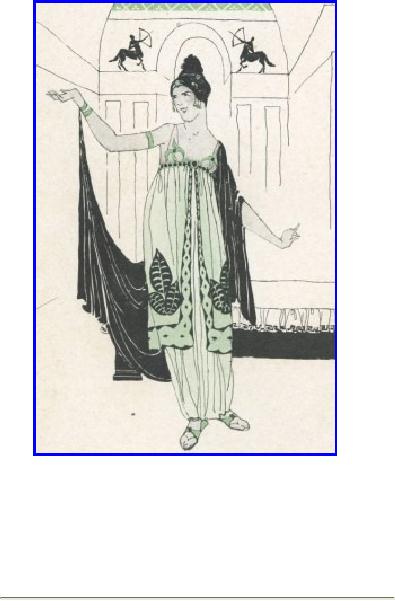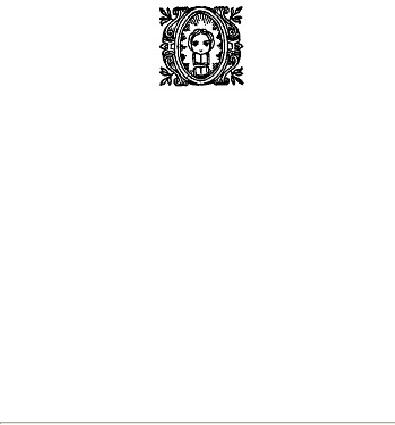 |
CONTENTS:ILLUSTRATIONS |
| A FEW HINTS FOR THE NOVICE WHO WOULD PLAN HER COSTUMES >> |

PLATE
I
Madame
Geraldine Farrar as Tha�s in
the
opera of
that name. It is a sketch made
from
life
for this book. Observe
the gilded wig and
richly
embroidered gown. They are
after
descriptions
of a costume worn by the
real
Tha�s.
It is a Greek type of costume
but not
the
familiar classic Greek of sculptured
story.
Tha�s
was a reigning beauty and acted in
the
theatre
of Alexandria in the early
Christian
era.
Sketched
for "Woman as
Decoration"
by
Thelma Cudlipp
Mme.
Geraldine Farrar in Greek
Costume
as Tha�s

WOMAN
AS DECORATION
BY
EMILY
BURBANK
ILLUSTRATED
NEW
YORK DODD, MEAD AND COMPANY
1917
COPYRIGHT,
1917
BY DODD, MEAD AND COMPANY, INC.
DEDICATED
to
V.
B. G.
FOREWORD
WOMAN AS DECORATION is intended as a sequel to
The
Art of Interior
Decoration
(Grace
Wood and Emily
Burbank).
Having
assisted in setting the
stage for woman, the
next logical step is
the
consideration
of woman, herself, as an important
factor in the decorative
scheme of
any
setting,--the vital spark to animate
all interior decoration,
private or public.
The
book in hand is intended as a
brief guide for the
woman who would
understand
her
own type,--make the most of
it, and know how simple a
matter it is to be
decorative
if she will but master the
few rules underlying all
successful dressing.
As
the costuming of woman is an
art, the history of that
art must be known--to
a
certain
extent--by one who would be an
intelligent student of our
subject. With the
assistance
of thirty-three illustrations to throw
light upon the text, we
have tried to
tell
the beguiling story of
decorative woman, as she
appears in frescoes and
bas
reliefs
of Ancient Egypt, on Greek
vases, the Gothic woman in
tapestry and stained
glass,
woman in painting, stucco and
tapestry of the Renaissance,
seventeenth,
eighteenth
and nineteenth century woman in
portraits.
Contemporary
woman's costume is considered, not as
fashion, but as
decorative
line
and colour, a distinct contribution to
the interior decoration of
her own home or
other
setting. In this department,
woman is given suggestions as to the
costuming of
herself,
beautifully and appropriately, in the
ball-room, at the opera, in
her boudoir,
sun-room
or on her shaded porch; in
her garden; when driving
her own car; by
the
sea,
or on the ice.
Woman
as Decoration has been
planned, in part, also to fill a need
very generally
expressed
for a handbook to serve as guide
for beginners in getting up costumes
for
fancy-dress
balls, amateur theatricals, or
the professional
stage.
We
have tried to shed light
upon period costumes and point
out ways of making
any
costume effective.
Costume
books abound, but so far as we
know, this is the first
attempt to confine
the
vast and perplexing subject
within the dimensions of a
small, accessible
volume
devoted
to the principles underlying
the planning of all costumes,
regardless of
period.
The
author does not advocate the
preening of her feathers as
woman's sole
occupation,
in any age, much less at
this crisis in the making of
world history; but
she
does lay great emphasis on
the fact that a woman owes
it to herself, her
family
and
the public in general, to be as
decorative in any setting, as
her knowledge of the
art
of dressing admits. This knowledge
implies an understanding of line,
colour,
fitness,
background, and above all, one's
own type. To know one's
type, and to have
some
knowledge of the principles
underlying all good dressing, is of
serious
economic
value; it means a saving of
time, vitality and
money.
The
watchword of to-day is efficiency,
and the keynote to modern
costuming,
appropriateness.
And so the spirit of the
time records itself in the
interesting and
charming
subdivision of woman's
attire.
One
may follow Woman Decorative
in the Orient on vase, fan,
screen and
kakemono;
as she struts in the stiff
manner of Egyptian bas
reliefs, across walls
of
ancient
ruins, or sits in angular serenity,
gazing into the future
through the narrow
slits
of Egyptian eyes, oblivious of
time; woman, beautiful in
the European sense,
and
decorative to the superlative
degree, on Greek vase and
sculptured wall. Here
in
rhythmic curves, she dandles
lovely Cupid on her toe;
serves as vestal virgin at
a
woodland
shrine; wears the bronze
helmet of Minerva; makes
laws, or as Penelope,
the
wife, wearily awaits her
roving lord. She moves in
august majesty, a
sore-tried
queen,
and leaps in merry laughter
as a care-free slave; pipes, sings and
plies the
distaff.
Sauntering on, down through
Gothic Europe, Tudor
England, the adolescent
Renaissance,
Bourbon France, into the
picturesque changes of the
eighteenth
century,
we ask, can one possibly escape
our theme--Woman as Decoration?
No,
for
she is carved in wood and
stone; as Mother of God and
Queen of Heaven
gleams
in the jeweled windows of
the church, looks down in
placid serenity on
lighted
altar; is woven in tapestry, in
fact dominates all art,
painting, stucco or
marble,
throughout the ages.
If
one would know the story of
Woman's evolution and retrogression--that
rising
and
falling tide in civilisation--we
commend a study of her as
she is presented in
Art.
A knowledge of her costume
frequently throws light upon
her age; a thorough
knowledge
of her age will throw light
upon her costume.
A
study of the essentials of
any costume, of any period,
trains the eye and mind
to
be
expert in planning costumes for
every-day use. One learns
quickly to
discriminate
between details which are
ornaments, because they have
meaning, and
those
which are only illiterate
superfluities; and one learns to master
many other
points.
It
is not within the province
of this book to dwell at
length upon national
costume,
but
rather to follow costume as it
developed with and reflected
caste, after human
society
ceased to be all alike as to
occupation, diversion and
interest.
In
the world of caste, costume
has gradually evolved until
it aims through
appropriateness,
at assisting woman to fulfil her
r�le. With peasants who
know only
the
traditional costume of their
province, the task must
often be done in spite of the
costume,
which is picturesque or grotesque,
inconvenient, even impossible;
but
long
may it linger to divert the
eye! Russia, Germany, France, Spain,
Italy, Poland,
Scandinavia,--all
have an endless variety of costumes,
rich in souvenirs of
folk
history,
rainbows of colour and bizarre in
line, but it is costuming
the woman of
fashion
which claims our
attention.
The
succeeding chapters will treat of woman,
the vital spark which gives
meaning
to
any setting--indoors, out of doors, at
the opera, in the ball-room,
on the ice--
where
you will. Each chapter
has to do with modern woman
and the historical
paragraphs
are given primarily to shed
light upon her
costume.
It
is shown that woman's
decorative appearance affects
her psychology, and
that
woman's
psychology affects her
decorative appearance.
Some
chapters may, at first glance,
seem irrelevant, but those
who have seriously
studied
any art, and then
undertaken to tell its story
briefly in simple,
direct
language,
with the hope of quickly
putting audience or reader in touch
with the
vital
links in the chain of
evidence, will understand the
author's claim that no
detour
which
illustrates the subject can
in justice be termed irrelevant. In
the detours often
lie
invaluable data, for one
with a mind for
research--whether author or
reader.
This
is especially true in connection
with our present task, which
involves
unravelling
some of the threads from the
tangled skein of religion,
dancing, music,
sculpture
and painting--that mass of bright and
sombre colour, of gold and
silver
threads,
strung with pearls and glittering
gems strangely broken by
age--which
tells
the epic-lyric tale of
civilisation.
While
we state that it is not our
aim to make a point of fashion as
such, some of our
illustrations
show contemporary woman as
she appears in our homes, on
our
streets,
at the play, in her garden,
etc. We have taken examples
of women's
costumes
which are pre-eminently
characteristic of the moment in
which we write,
and
as we believe, illustrate those laws
upon which we base our
deductions
concerning
woman as decoration. These laws are:
appropriateness of her costume
to
the occasion; consideration of
the type of wearer;
background against which
costume
is to be worn; and all
decoration (which includes
jewels), as detail
with

raison
d'�tre. The
body should be carried with
form (in the sporting
sense), to assist
in
giving line to the
costume.
The
chic
woman
is the one who understands the
art of elimination in costumes.
Wear
your costumes with conviction--by
which we mean decide what
picture you
will
make of yourself, make it and then enjoy
it! It is only by letting
your
personality
animate your costume that
you make yourself superior
to the lay figure
or
the sawdust doll.
CONTENTS
A
FEW HINTS FOR THE NOVICE WHO WOULD PLAN HER
I
1
COSTUMES
Rules
having economic value while
aiming at decorativeness.--
Lines
and colouring emphasised or modified by
costuming.--
Temperaments
affect carriage of the body.--Line of
body
affects
costume.--Technique of controlling the
physique.--The
highly
sensitised woman.--Costuming an art.--Studying
types.
--Starring
one's own good points.--Beauty
not so fleeting as is
supposed
if costume is adapted to its
changing aspects.--
Masters
in art of costuming often
discover and star previously
unrecognised
beauty.--Establishing the habit of those
lines and
colours
in gowns, hats, gloves, parasols,
sticks, fans and
jewels
which
are your own.--The
intelligent purchaser.--The
best
dressed
women.--Value of understanding one's
background.--
Learning
the art of understanding
one's background.--Learning
the
art of costuming from
masters of the art.--How to
proceed
with
this study.--Successful costuming
not dependent upon
amount
of money spent upon it.--An
example
II
23
THE LAWS UNDERLYING ALL COSTUMING OF WOMAN
Appropriateness
keynote of costuming to-day.--Five
salient
points
to be borne in mind when
planning a costume.--Where
English,
French, and American women
excel in art of
costuming.--Feeling
for line.--To make our
points clear
constant
reference to the stage is
necessary.--Bakst and Poiret.
--Turning
to the Orient for line and
colour.--Keeping costume
in
same key as its
settings.--How to know your
period; its line,
colours
and characteristic details.--Studying costumes
in
Gothic
illuminations
III
HOW TO DRESS YOUR TYPE
46
A
FEW POINTS APPLYING TO ALL COSTUMES.--Background.
--Line
and colour of costumes to bring
out the individuality
of
wearer.--The
chic woman defined.--Intelligent
expressing of
self
in mise-en-sc�ne.--Selecting
one's colour scheme

IV
54
THE PSYCHOLOGY OF CLOTHES
Effect
of clothes upon manners.--The
natural instinct for
costuming,
"clothes sense."--Costuming affecting
psychology
of
wearer.--Clothes may liberate or
shackle the spirit of
women,
be a tyrant or magician's wand.--Follow
colour instinct
in
clothes as well as
housefurnishings
ESTABLISH HABITS OF CARRIAGE WHICH CREATE GOOD
V
66
LINE
Woman's
line result of habits of a
mind controlled by
observations,
conventions, experiences and attitudes
which
make
her personality.--Training lines of
physique from
childhood;
an example.--A knowledge of how to
dress
appropriately
leads to efficiency
VI
74
COLOUR IN
WOMAN'S COSTUME
Colour
hall-mark of to-day.--Bakst, Rheinhardt
and Granville
Barker,
teachers of the new colour
vocabulary.--PORTABLE
BACKGROUNDS
VII
FOOTWEAR
85
Importance
of carefully considering
extremities.--What
constitutes
a costume.--Importance of learning how to
buy, put
on
and wear each detail of
costume if one would be a
decorative
picture.--Spats.--Stockings.--Slippers.--Buckles
VIII
94
JEWELRY AS DECORATION
Considered
as colour and line not with
regard to intrinsic worth.
--To
complete a costume or furnish
keynote upon which to
build
a costume.--Distinguished jewels with
historic
associations
worn artistically; examples.--Know
what jewels
are
your affair as to colour, size,
and shape.--To know
what
one
can and cannot wear in all
departments of costuming
prepares
one to grasp and make use of expert
suggestions. How
fashions
come into being.--One of the
rules as to how
jewels
should
be worn.--Gems and paste
IX
111
WOMAN DECORATIVE IN HER
BOUDOIR
Neglig�e
or tea-gown belongs to this
intimate setting.--Fortuny
the
artist designer of tea-gowns.--Sibyl
Sanderson.--The
decorative
value of a long string of
beads.--Beauty which is
the
result
of conscious effort.--Bien
soin� a hall-mark
of our period
X
116
WOMAN DECORATIVE IN HER
SUN-ROOM

Since
a winter sun-room is planned to
give the illusion of
summer,
one's costuming for it
should carry out the
same idea.
--The
sun-room provides a means
for using up last
summer's
costumes.--The
hat, if worn, should suggest
repose, not action.
--The
age and habits of those occupying a
sun-room dictate the
exact
type of costume to be worn.--Colour
scheme
XI
124
I.
WOMAN DECORATIVE IN HER GARDEN
In
the garden the costume
should have a decorative
outline but
simple
colour scheme which harmonises
with background of
flowers.--White,
grey, or one note of colour
preferable.--The
flowers
furnish variety and colour.--Lady de
Bathe (Mrs.
Langtry)
in her garden at Newmarket,
England
II.
WOMAN DECORATIVE ON
THE LAWN
One
may be a flower or a bunch of
flowers for colour
against
the
unbroken sweep of green underfoot and
background of
shrubs
and trees.--Chic outline and interesting
detail, as well as
colour,
of distinct value in a costume
for lawn.--How to
cultivate
an unerring instinct for
what is a successful
costume
for
any given occasion
III.
WOMAN DECORATIVE ON
THE BEACH
If
one would be a contribution to the
picture, figure as white
or
vivid
colour on beach, deck of steamer or
yacht
XII
WOMAN AS
DECORATION WHEN SKATING
134
Line
of the body all
important.--The necessity of
mastering
form
to
gain efficiency in any line;
examples.--The traditional
skating
costume has the lead
XIII
145
WOMAN DECORATIVE IN HER MOTOR
CAR
The
colour of one's car inside and
out important factor in
effect
produced
by one's carefully chosen
costume
XIV
HOW TO
GO ABOUT PLANNING A PERIOD COSTUME
154
Period.--Background.--Outline.--Materials.--Colour
scheme.
--Detail
with meaning.--Authorities.--Consulting
portraits by
great
masters.--Geraldine Farrar.--Distinguished
collection of
costume
plates.--One result of planning
period costumes is the
opening
up of vistas in history.--Every detail of
a period
costume
has its fascinating story
worth the
knowing.--Brief
historic
outline to serve as key to the
rich storehouse of
important
volumes on costumes and the distinguished
textless
books
of costume plates.--Period of fashions in
costumes
developing
without nationality.--Nationality declared in
artistry

of
workmanship and the modification or
exaggeration of an
essential
detail according to national or
individual temperament.
--Evolution
of woman's
costume.--Assyria.--Egypt.--
Byzantium.--Greece.--Rome.--Gothic
Europe.--Europe of
the
Renaissance,--seventeenth, eighteenth and
nineteenth
century
through Mid-Victorian period.--Cord
tied about waist
origin
of costumes for women and
men
XV
THE STORY OF PERIOD COSTUMES
172
A
R�SUM�
Woman
as seen in Egyptian sculpture-relief; on
Greek vase; in
Gothic
stained glass; carved stone; tapestry;
stucco; and
painting
of the Renaissance; eighteenth and
nineteenth century
portraits.--Art
throughout the ages reflects
woman in every
r�le;
as companion, ruler, slave,
saint, plaything, teacher,
and
voluntary
worker.--Evolution of outline of woman's
costume,
including
change in neck; shoulder; evolution of
sleeve; girdle;
hair;
head-dress; waist line;
petticoat.--Gradual disappearance
of
long, flowing lines
characteristic of Greek and
Gothic
periods.--Demoralisation
of Nature's shoulder and
hip-line
culminates
in the Velasquez edition of Spanish
fashion and the
Marie
Antoinette extravaganzas
XVI
DEVELOPMENT OF GOTHIC COSTUME
192
Gothic
outline first seen as early
as fourth century.--Costume
of
Roman-Christian women.--Ninth
century.--The Gothic
cape
of
twelfth, thirteenth and fourteenth
centuries made familiar
on
the
Virgin and saints in sacred art.--The
tunic.--Restraint in
line,
colour, and detail gradually
disappear with
increased
circulation
of wealth until in fifteenth
century we see
humanity
over-weighted
with rich brocades, laces, massive
jewels, etc.
THE VIRGIN IN ART
Late
Middle Ages.--Sovereignty of the
Virgin as explained in
"The
Cathedrals of Mont St. Michel and
Chartres," by Henry
Adams.--Woman
as the Virgin dominates art
of twelfth,
thirteenth,
and fourteenth centuries.--The
girdle.--The round
neck.--The
necklace, etc.
XVII
THE RENAISSANCE
214
SIXTEENTH AND SEVENTEENTH CENTURIES
Pointed
and other head-dresses with
floating veils.--Neck
low
off
shoulders.--Skirts part as waist-line
over petticoat.--Wealth
of
Roman Empire through new
trade channels had led to
importation
of richly coloured Oriental
stuffs.--Same wealth

led
to establishing looms in Europe.--Clothes
of man like his
over-ornate
furniture show debauched and
vulgar taste.--The
good
Gothic lines live on in costumes of
nuns and priests.--The
Davanzati
Palace collection, Florence,
Italy.--Long pointed
shoes
of the Middle Ages give way
to broad square ones.--
Gorgeous
materials.--Hats.--Hair.--Sleeves.--Skirts.--
Crinolines.--Coats.--Overskirts
draped to develop
into
panniers
of Marie Antoinette's time.--Directoire
reaction to
simple
lines and materials
XVIII
233
EIGHTEENTH CENTURY
Political
upheavals.--Scientific
discoveries.--Mechanical
inventions.--Chemical
achievements.--Chintz or stamped
linens
of Jouy near Versailles.--Painted
wall-papers after the
Chinese.--Simplicity
in costuming of woman and
man
XIX
WOMAN IN
THE VICTORIAN PERIOD
241
First
seventy years of nineteenth
century.--"Historic Dress in
America"
by Elizabeth McClellan.--Hoops, wigs,
absurdly
furbished
head-dresses, paper-soled shoes, bonnets
enormous,
laces
of cobweb, shawls from
India, rouge and
hair-grease,
patches
and powder, laced waists, and
"vapours."--Man still
decorative
XX
SEX IN
COSTUMING
244
"European
dress."--Progenitor of costume worn by
modern
men.--The
time when no distinction was
made between
materials
used for man and
woman.--Velvets, silks, satins,
laces,
elaborate cuffs and collars, embroidery,
jewels and
plumes
as much his as hers
XXI
LINE AND
COLOUR OF COSTUMES IN HUNGARY
252
In
a sense colour a sign of
virility.--Examples.--Studying
line
and
colour in Magyar Land.--In
Krakau, Poland,--A
highly
decorative
Polish peasant and her
setting
XXII
265
STUDYING LINE AND COLOUR IN RUSSIA
Kiev
our headquarters.--Slav temperament an
integral part of
Russian
nature expressed in costuming as
well as folk songs
and
dances
of the people.--Russian woman of
the fashionable
world.--The
Russian pilgrims as we saw them
tramping over
the
frozen roads to the shrines
of Kiev, the Holy City
and
ancient
capital of Russia at the close of the
Lenten season.--
Their
costumes and their psychology
XXIII
276
MARK TWAIN'S
LOVE OF COLOUR IN ALL
COSTUMING

Wrapped
in a crimson silk dressing-gown on a
balcony of his
Italian
villa in Connecticut, Mark
Twain dilated on the value
of
brilliant
colour in man's costuming.--His creative,
picturing-
making
mind in action.--Other themes
followed
XXIV
283
THE ARTIST AND HIS
COSTUME
A
God-given sense of the
beautiful.--The artist nature
has
always
assumed poetic license in
the matter of dress.--Many
so
-called
affectations have raison
d'�tre.--Responding
to texture,
colour
and line as some do to music
and scenery.--How
Japanese
actors train themselves to act
women's parts by
wearing
woman's costumes off the
stage.--This cultivates
the
required
feeling
for
the costumes.--The woman devotee
to
sports
when costumed.--Richard Wagner's
responsiveness to
colour
and texture.--Clyde Fitch's sensitiveness
to the same.--
The
wearing of jewels by men.--King
Edward VII.--A
remarkable
topaz worn by a Spaniard.--Its
undoing as a
decorative
object through its
resetting
XXV
IDIOSYNCRASIES IN COSTUME
292
Fashions
in dress all powerful
because they seize upon
the
public
mind.--They become the
symbol of manners and
affect
human
psychology.--Affectations of the youth of
Athens.--Les
Merveilleux,
Les Encroyables, the
Illuminati.--Schiller during
the
Storm and Stress Period.--Venetian
belles of the
sixteenth
century.--The
Cavalier
Servente of the
seventeenth century.--
Mme.
R�camier scandalised London in
eighteenth century by
appearing
costumed � la Greque.--Mme. Jerome
Bonaparte, a
Baltimore
belle, followed suit in
Philadelphia.--Hour-glass
waist-line
and attendant "vapours" were
thought to be in the
r�le
of
a high-born Victorian
miss.--Appropriateness the
contribution
of our day to the story of
woman's costuming
XXVI
296
NATIONALITY IN COSTUME
When
seen with perspective the costumes of
various periods
appear
as distinct types though to
the man or woman of
any
particular
period the variations of the
type are bewildering
and
misleading.--Having
followed the evolution of
the costume of
woman
of fashion which comes under
the general head of
European
dress, before closing we
turn to quite another
field,
that
of national costumes.--Progress levels
national differences,
therefore
the student must make the
most of opportunities to
observe.--Experiences
in Hungary
XXVII
306
MODELS

Historical
interest attaches to fashions in
woman's costuming.--
One
of the missions of art is to make
subtle the obvious.--
Examples
as seen in 1917
XXVIII
313
WOMAN COSTUMED FOR
HER WAR
JOB
The
Pageant of Life shows that
woman has played opposite
man
with
consistency and success
throughout the ages.--Apropos
of
this,
we quote from Philadelphia
Public
Ledger, for
March 25,
1917,
an impression of a woman of to-day
costumed
appropriately
to get efficiency in her war
work
324
IN CONCLUSION
A
brief review of the chief
points to be kept in mind by
those
interested
in the costuming of woman so
that she figures as a
decorative
contribution to any
setting
ILLUSTRATIONS
MME.
GERALDINE
FARRAR IN GREEK COSTUME
I
(Frontispiece)
AS
THA�S
Sketched
by Thelma Cudlipp
WOMAN IN ANCIENT EGYPTIAN SCULPTURE-
II
9
RELIEF
III
WOMAN IN GREEK ART
19
IV
29
WOMAN ON GREEK VASE
WOMAN IN GOTHIC ART
V
39
Portrait
Showing Pointed
Head-dress
WOMAN IN ART OF THE RENAISSANCE
VI
49
Sculpture-relief
in Terra-cotta: The
Virgin
WOMAN IN ART OF THE RENAISSANCE
VII
Sculpture-relief in Terra-cotta:
Holy Women
59
TUDOR ENGLAND
VIII
Portrait of Queen
Elizabeth
69
IX
79
SPAIN--VELASQUEZ PORTRAIT
EIGHTEENTH CENTURY ENGLAND
X
89
Portrait
by Thomas Gainsborough
BOURBON FRANCE
XI
99
Portrait
of Marie Antoinette by Madame
Vig�e Le
Brun
COSTUME OF EMPIRE PERIOD
XII
An English
Portrait
109
EIGHTEENTH CENTURY COSTUME
XIII
Portrait by Gilbert
Stuart
119
VICTORIAN PERIOD (ABOUT 1840)
XIV
Mme. Adeline Gen�e
in Costume
129
LATE NINETEENTH CENTURY (ABOUT 1890) A
XV
139
Portrait
by John S. Sargent
A
MODERN PORTRAIT
XVI
By John W.
Alexander
149
A
PORTRAIT OF MRS.
PHILIP
M. LYDIG
XVII
By I. Zuloaga
159
MRS.
LANGTRY
(LADY DE BATHE)
IN EVENING
XVIII
169
WRAP
MRS.
COND�
NAST IN STREET DRESS
XIX
Photograph by Baron de
Meyer
179
XX
189
MRS.
COND�
NAST IN EVENING DRESS
XXI
MRS.
COND�
NAST IN GARDEN COSTUME
199
XXII
MRS.
COND�
NAST IN FORTUNY TEA
GOWN
209
XXIII
219
MRS.
VERNON
CASTLE IN BALL COSTUME
MRS.
VERNON
CASTLE IN AFTERNOON COSTUME-
XXIV
229
-WINTER

MRS. VERNON CASTLE IN AFTERNOON COSTUME-
XXV
-SUMMER
239
MRS.
VERNON
CASTLE COSTUMED � LA
GUERRE
XXVI
249
FOR
A WALK
XXVII
259
MRS.
VERNON
CASTLE--A
FANTASY
MODERN SKATING COSTUME--1917
XXVIII
269
Winner
of Amateur Championship of
Fancy
Skating
XXIX
MODERN SILHOUETTE--1917
279
Tailor-Made.
Drawn from Life by Elisabeth
Searcy
A
TAPP�'S CREATIONS
XXX
289
Sketched
for Woman
as Decoration by
Thelma
Cudlipp
MISS ELSIE DE
WOLFE IN COSTUME OF RED
XXXI
299
CROSS NURSE
MME.
GERALDINE
FARRAR IN SPANISH COSTUME
XXXII
309
AS
CARMEN
From
Photograph by Courtesy of Vanity
Fair
MME.
GERALDINE
FARRAR IN JAPANESE
XXXIII
319
COSTUME AS MADAME BUTTERFLY
Sketched
by Thelma Cudlipp
"The
Communion of men upon earth
abhors identity more
than
nature does a vacuum.
Nothing so shocks and repels the
living
soul as a row of exactly
similar things, whether
it
consists
of modern houses or of modern people, and
nothing
so
delights and edifies as
distinction."
COVENTRY PATMORE.
"Whatever
piece of dress conceals a woman's
figure, is bound,
in
justice, to do so in a picturesque
way."
From
an Early Victorian Fashion
Paper.
Table of Contents:
- A FEW HINTS FOR THE NOVICE WHO WOULD PLAN HER COSTUMES
- THE LAWS UNDERLYING ALL COSTUMING OF WOMAN
- HOW TO DRESS YOUR TYPE
- THE PSYCHOLOGY OF CLOTHES
- ESTABLISH HABITS OF CARRIAGE WHICH CREATE GOOD LINE
- COLOUR IN WOMAN'S COSTUME
- FOOTWEAR
- JEWELRY AS DECORATION
- WOMAN DECORATIVE IN HER BOUDOIR
- WOMAN DECORATIVE IN HER SUN-ROOM
- I. WOMAN DECORATIVE IN HER GARDEN:WOMAN DECORATIVE ON THE LAWN
- WOMAN AS DECORATION WHEN SKATING
- WOMAN DECORATIVE IN HER MOTOR CAR
- HOW TO GO ABOUT PLANNING A PERIOD COSTUME
- I. THE STORY OF PERIOD COSTUMES:II. EGYPT AND ASSYRIA
- DEVELOPMENT OF GOTHIC COSTUME
- THE RENAISSANCE
- EIGHTEENTH CENTURY
- WOMAN IN THE VICTORIAN PERIOD
- SEX IN COSTUMING
- LINE AND COLOUR OF COSTUMES IN HUNGARY
- STUDYING LINE AND COLOUR IN RUSSIA
- MARK TWAIN'S LOVE OF COLOUR IN ALL COSTUMING
- THE ARTIST AND HIS COSTUME
- IDIOSYNCRASIES IN COSTUME
- NATIONALITY IN COSTUME
- MODELS
- WOMAN COSTUMED FOR HER WAR JOB
- IN CONCLUSION